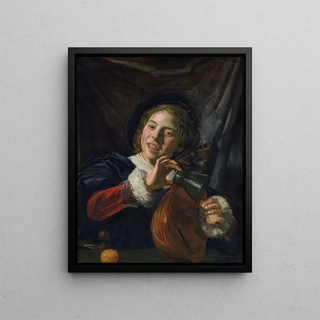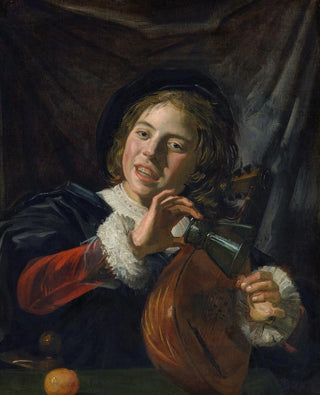Painting Boy with a Lute - Frans Hals | Art print


View from behind

Frame (optional)
At the heart of the Dutch Golden Age, the artwork "Garçon avec un luth" by Frans Hals emerges as a vibrant testament to the artistic virtuosity of its time. This painting, created in the 17th century, captures not only a fleeting moment of daily life but also a profound essence of youth, music, and emotion. The young boy, with his lute, embodies a silent melody, a harmony between the instrument and its performer. The piece invites us to contemplate the beauty of the moment while awakening an insatiable curiosity about the stories hidden behind the enigmatic smile of this young musician.
Style and uniqueness of the artwork
Frans Hals stands out for his exceptional mastery of portraiture and his ability to infuse his subjects with vibrant life. In "Garçon avec un luth," Hals's technique of loose and spontaneous brushwork is highlighted, giving the canvas a remarkable lightness and fluidity. The play of light and shadow, along with the contrast between warm and cool colors, creates an almost tangible atmosphere. The boy's gaze, both direct and dreamy, seems to capture the viewer, establishing a silent dialogue that transcends time. This work is emblematic of the Baroque style, where emotion and movement are conveyed through bold brushstrokes and a dynamic composition. Every detail, from the delicately rendered lute to the folds of the clothing, testifies to Hals's meticulous attention to his creations.
The artist and his influence
Frans Hals, born in Antwerp in 1582, is one of the pioneers of genre painting and portraiture in the 17th century. His innovative approach influenced many artists, both contemporaries and future generations. Hals was able to capture the spirit of his era, revealing the daily life of the Dutch with rare authenticity. His use of light and his quick painting technique paved the way for generations of artists, notably the Impressionists, who saw in him a master of immediacy. By exploring themes of everyday life, Hals also contributed to the valorization of the portrait genre, transforming

Matte finish

View from behind

Frame (optional)
At the heart of the Dutch Golden Age, the artwork "Garçon avec un luth" by Frans Hals emerges as a vibrant testament to the artistic virtuosity of its time. This painting, created in the 17th century, captures not only a fleeting moment of daily life but also a profound essence of youth, music, and emotion. The young boy, with his lute, embodies a silent melody, a harmony between the instrument and its performer. The piece invites us to contemplate the beauty of the moment while awakening an insatiable curiosity about the stories hidden behind the enigmatic smile of this young musician.
Style and uniqueness of the artwork
Frans Hals stands out for his exceptional mastery of portraiture and his ability to infuse his subjects with vibrant life. In "Garçon avec un luth," Hals's technique of loose and spontaneous brushwork is highlighted, giving the canvas a remarkable lightness and fluidity. The play of light and shadow, along with the contrast between warm and cool colors, creates an almost tangible atmosphere. The boy's gaze, both direct and dreamy, seems to capture the viewer, establishing a silent dialogue that transcends time. This work is emblematic of the Baroque style, where emotion and movement are conveyed through bold brushstrokes and a dynamic composition. Every detail, from the delicately rendered lute to the folds of the clothing, testifies to Hals's meticulous attention to his creations.
The artist and his influence
Frans Hals, born in Antwerp in 1582, is one of the pioneers of genre painting and portraiture in the 17th century. His innovative approach influenced many artists, both contemporaries and future generations. Hals was able to capture the spirit of his era, revealing the daily life of the Dutch with rare authenticity. His use of light and his quick painting technique paved the way for generations of artists, notably the Impressionists, who saw in him a master of immediacy. By exploring themes of everyday life, Hals also contributed to the valorization of the portrait genre, transforming
12,34 €






